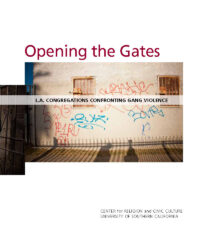While it might be tempting to focus exclusively on the assets of religion in addressing community violence issues, and there are many, we believe that a practical approach of providing training and resources, can match good intentions with positive results. There are theological reasons that churches are not engaging the gang problem in their community; there are organizational reasons related to capacity that block them from this engagement; and many congregations lack fundamental knowledge about their community and its resources that would be helpful in developing funding and program strategies. In even the most crime-stricken neighborhoods, only a few people are actually engaging in violent activities. Consequently, quite a few churches are sheltered locations where people go to escape the problems in their community.
As Karl Marx rightly noted, religion can be an opiate to blunt the pain of everyday existence. However, religion also has the potential to inspire people to transform the conditions that give rise to this pain.
Gang violence can be addressed at several different levels. Homeboy Industries, led by Father Greg Boyle, is a wonderful example of a program that is helping young adults transition out of gangs. His motto that “nothing stops a bullet like a job” is absolutely true. However, there are other sources of community and gang violence besides joblessness. For many youth, gangs function as a surrogate family. A gang is the place where they seek identity and community. Many young people who join gangs have never been deeply loved; they have not been socialized into the values that promote healthy communities; and they have few skills that would enable them to be productive members of society as adults. As a result, it is understandable that they seek identification with a gang and engage in acts of violence that further erode the structures of a healthy community.
We are under no illusion that religion can solve the problem of violence in Los Angeles. However, it can play an important role in partnering with other community resources. Specifically, it can help strengthen family structures; it can provide mentors to youth that lack positive parental role models in their lives; it can create alternative activities to gang-banging, such as after school programs and sports programs; its members can befriend youth who are in the juvenile justice system and help insure that they receive a fair hearing and trial; and it can advocate politically for programs and policies that will challenge the complex factors that make their communities seedbeds of violence. IVP fellows were exposed to model programs that address each of these potential roles that religion can play in their community, although scant attention was paid to the complex problem of building healthy family structures—which, in itself, warrants a separate program.
Congregations and faith-based organizations are poised to do amazing things in their communities, and there are examples of successes particularly among larger congregations and faith-based organizations. However, for many congregations, especially smaller ones, there are many theological and organizational barriers that are problematic. Our experience with the Institute for Violence Prevention shows that many congregations and faith-based organizations have a desire to help, but often that desire is not matched with the necessary knowledge and organizational capacity. After their IVP experience however, many fellows were inspired to expand the scope of their ministries to include people from other ethnic groups, or to develop new recreational and mentoring activities to prevent youth from becoming involved in gangs.
We have discovered that desire alone or good intention is not enough. Stable institutions must be established before any programmatic interventions can be made. Further, developing stable institutions requires ongoing attention, first for basic organizational issues, then technical assistance, and finally strengthening organizations to the point where they can work with others to begin to address policy issues. We believe that ongoing investment into building stable organizations, solid programming, and eventual policy engagement must be a priority if the potential of congregations is to be realized in communities. Without this investment, some outlier successes could result, but real change in local neighborhoods will not occur.
The Institute for Violence Prevention demonstrated that bridging across cultures on issues of importance is an effective way of addressing community concerns and there is an openness and interest in participating in such multi-cultural initiatives. Hands-on training through organizations with proven effectiveness, when combined with classroom experience, is an effective method of engaging communities on issues of importance. The program proved to be successful in helping participants gain crucial skills, such as program development, campaigning, and identifying and targeting policy areas and concerns, while also inspiring leaders to action and generating networks across cultural boundaries amongst equally motivated and like-minded faith leaders.
Download the PDF of the report to read:
Postscript – Cecil Murray Center for Community Engagement
Appendix – Method
IVP Organizational Partners
Richard Flory is the executive director of the USC Center for Religion and Civic Culture.
Donald E. Miller is the co-founder of the USC Center for Religion and Civic Culture.
Brie Loskota is the former executive director (2016-2021) of the USC Center for Religion and Civil Culture.
